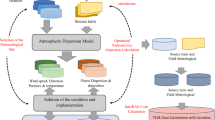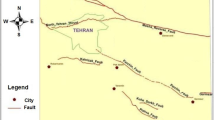Abstract
The US Environmental Protection Agency’s short-range atmospheric dispersion model (AERMOD 12345) is a good candidate for radiological dose calculations to the general public and the environment. It advanced capability should provide better confidence in the accuracy of offsite dose and risk assessment. The code has been used to compute the scaling factors for air concentration and ground level deposition of fission products based on routine and hypothetical accident releases from the NPP site in Geregu, Nigeria (7°33′N, 6°41′E). All computations were within the 16 km emergency planing zone of a generic reactor design considered by the study. The scaling factors have been used to assess the potential environmental risk of the NPP using an integrated approach to the assessment and management of environmental risks from ionizing radiation (D-ERICA). Obtained results should provide baseline information for decision making in terms of operation license provision for the pioneer NPP.










Similar content being viewed by others
References
Abila N (2010) Biofuels adoption in Nigeria: a preliminary review of feedstock and fuel production potentials. Manag Environ Qual Int J 21(6):785–795
Aduba O (2012) Nigeria to attain 4000 MW from nuclear power plants by 2030. Guardian Newspaper 18 July, 2012
Agu MN (2012) Preparation for environmental impact assessment for the first nuclear power plant. IAEA Technical meeting on environmental issues in new Nuclear Power Programs 20–23 March, Vienna, Austria
Akorede M, Hizam H, Ab Kadir M, Aris I, Buba S (2012) Mitigating the anthropogenic global warming in the electric power industry. Renew Sustain Energy Rev 16(5):2747–2761
Aliyu AS, Ramli AT, Saleh MA (2013a) Nigeria electricity crisis: power generation capacity expansion and environmental ramifications. Energy 61:345–367
Aliyu AS, Ramli AT, Saleh MA (2013b) First nuclear power in Nigeria: an attempt to address the energy crisis? Int J Nucl Gov Econ Ecol 4(1):1–10
Beresford N, Brown J, Copplestone D, Garnier-Laplace J, Howard B, Larsson C, Oughton D, Pröhl G, Zinger I (2007) D-ERICA: an integrated approach to the assessment and management of environmental risks from ionising radiation. Description of purpose, methodology and application. EC contract number FI6R-CT-2004-508847. European Commission, Brussels
Caputo M, Giménez M, Schlamp M (2003) Intercomparison of atmospheric dispersion models. Atmos Environ 37(18):2435–2449
Chino M, Nakayama H, Nagai H, Terada H, Katata G, Yamazawa H (2011) Preliminary estimation of release amounts of 131I and 137Cs accidentally discharged from the Fukushima Daiichi nuclear power plant into the atmosphere. J Nucl Sci Technol 48(7):1129–1134
Cimorelli A, Perry S, Venkatram A, Weil J, Paine R, Wilson R, Lee R, Peters W, Brode R, Paumier J (2004) AERMOD: description of model formulation. US Environmental Protection Agency, North Carolina
Desnoyers Y, Chilès J-P, Dubot D, Jeannée N, Idasiak J-M (2011) Geostatistics for radiological evaluation: study of structuring of extreme values. Stoch Environ Res Risk Assess 25(8):1031–1037
Elogne SN, Hristopulos DT, Varouchakis E (2008) An application of Spartan spatial random fields in environmental mapping: focus on automatic mapping capabilities. Stoch Environ Res Risk Assess 22(5):633–646
Fischer G, Ermolieva T, Ermoliev Y, Sun L (2009) Risk-adjusted approaches for planning sustainable agricultural development. Stoch Environ Res Risk Assess 23(4):441–450
Harris JT (ed) (2011) Radiological releases and environmental monitoring at commercial nuclear power plants. In Tech
Hoeve JET, Jacobson MZ (2012) Worldwide health effects of the Fukushima Daiichi nuclear accident. Energy Environ Sci 5(9):8743–8757
Homann SG (2011) HotSpot. Health Physics Codes for the PC Lawrence Livermore National Laboratory UCRL-MA-106315
IAEA (2002) Dispersion of radioactive material in air and water and consideration of population distribution in site evaluation for nuclear power plants. Safety Series No. NS-G-3.2. International Atomic Energy Agency, Vienna
IAEA (2011) Meteorological and hydrological hazards in site evaluation for nuclear Installations. Specific Safety Guide No. SSG-18
ICRP (1982) Atmospheric dispersion models for potential accident consequence assessments at nuclear power plants: regulatory guide (RG) 1.145. Revision lUS NRC, Washington, DC
ICRP (2007) ICRP Publication 103. Ann ICRP 37(2.4):2
ICRP (1990) ICRP Publication 60. Ann ICPR 21(1–3)
Iwayemi A (2008) Nigeria’s dual energy problems: policy issues and challenges. Int Assoc Energy Econ 17–21
Jibiri N (2001) Assessment of health risk levels associated with terrestrial gamma radiation dose rates in Nigeria. Environ Int 27(1):21–26
Jilani AB (2009) Atmospheric dispersion and consequence modeling of radiological emergencies. Pakistan Institute of Engineering and Applied Sciences
Kamada N, Saito O, Endo S, Kimura A, Shizuma K (2012) Radiation doses among residents living 37 km northwest of the Fukushima Daiichi Nuclear Power Plant. J Environ Radioact 110:84–89
Katata G, Terada H, Nagai H, Chino M (2012) Numerical reconstruction of high dose rate zones due to the Fukushima Daiichi Nuclear Power Plant accident. J Environ Radioact 111:2–12
Kennedy-Darling J, Hoyt N, Murao K, Ross A (2008) The energy crisis of Nigeria: an overview and implications for the future. The University of Chicago, Chicago
Khandakar HA, Moritomi H (2013) Assessment of ambient mercury deposition fluxes by numerical air quality modeling. Air Qual Atmos Health 6(3):629–640
Kristoferson L (1979) Energy and environment in East Africa: report from a workshop. Ambio 8:220–221
Larsson C-M (2008) An overview of the ERICA integrated approach to the assessment and management of environmental risks from ionising contaminants. J Environ Radioact 99(9):1364–1370
McMahon C, Kelleher K, McGinnity P, Organo C, Smith K, Currivan L, Ryan T (2013) Proposed nuclear power plants in the UK—potential radiological implications for Ireland. Radiological Protection Institute of Ireland
Mutshinda CM, Antai I, O’Hara RB (2008) A probabilistic approach to exposure risk assessment. Stoch Environ Res Risk Assess 22(4):441–449
Nabeshima K, Türkcan E, Ciftcioglu Ö (1993) Real-time nuclear power plant monitoring with adaptively trained neural network. Springer, Amsterdam
Nabeshima K, Suzudo T, Suzuki K, Türkcan E (1998) Real-time nuclear power plant monitoring with neural network. J Nucl Sci Technol 35(2):93–100
Napier BA (2006) GENII version 2 users’ guide. Pacific Northwest National Laboratory report PNNL-14583, Rev, vol 3
Napier BA, Strenge DL, Ramsdell JV, Eslinger PW, Fosmire C (2004) GENII Version 2: Software Design Document. Pacific Northwest National Laboratory
Nelson N, Kitchen K, Maryon R (2002) Assessment of routine atmospheric discharges from the Sellafield nuclear installation—Cumbria UK. Atmos Environ 36(19):3203–3215
Nuttall WJ (2004) Nuclear renaissance: technologies and policies for the future of nuclear power. Taylor and Francis, New York
Obadote D (2009) Energy crisis in Nigeria: technical issues and solutions. In: Power sector prayer conference June, 2009
Ojo E (2009) Manufacturers need 2,000 MW of electricity to stay afloat-man. BusinessDay Nigeria, Tuesday, 21 July 2009
Okafor E, Joe-Uzuegbu C (2010) Challenges to development of renewable energy for electric power sector in Nigeria. Int J Acad Res 2(2):211–216
Perry SG, Cimorelli AJ, Paine RJ, Brode RW, Weil JC, Venkatram A, Wilson RB, Lee RF, Peters WD (2005) AERMOD: a dispersion model for industrial source applications. Part II: model performance against 17 field study databases. J Appl Meteorol 44(5):694–708
Sambo A (2007) Alternative generation and renewable energy. Paper presented at the 2nd Power Business Leaders Summit, Ibom Gulf Resort, Akwa Ibom State 12th–14th December
Sambo AS, Garba B, Zarma IH, Gaji MM (2012) Electricity generation and the present challenges in the Nigerian power sector. J Energy Power Eng 6(7):1050–1059
Smith K, Organo C, Somerville S, Hanley O, McMahon C (2012) Comparison of atmospheric dispersion model outputs and radioactivity measurements made in Ireland following the Fukushima nuclear emergency. Paper presented at the 13th International Congress of the International Radiation Protection Association Glasgow, 14–18 May 2012
Torrud J, Saetre P (2013) Assessment of long-term radiological effects on plants and animal from deep geological respiratory: no discernible impact detected. Ambio 42:506–516
Tuner DB, Richard CCM, Schulze H, QEP PE (2007) In: Practical guide to atmospheric dispersion modelling. Trinity Consultant, Texas
Vujić J, Antić DP, Vukmirović Z (2012) Environmental impact and cost analysis of coal versus nuclear power: the US case. Energy 45(1):31–42
WNA (2011) Comparison of lifecycle greenhouse gas emissions of various electricity generation sources. World Nuclear Association, London
Yao R (2011) Atmospheric dispersion of radioactive materials in radiological risk assessment and emergency response. Prog Nucl Sci Technol 1:7–13
yLeóns SB (2011) Panel on safety, health and the environment: implications of nuclear power growth. Health Phys 100:12–13
Youn H, Lim BI, Lee EY, Choi Y (2011) The impact of the risk environment and energy prices to the budget of Korean households. Stoch Environ Res Risk Assess 25(3):323–330
Acknowledgments
Our sincere appreciation goes to the Malaysian Ministry of Higher education and the Universiti Teknologi Malaysia for providing a research grant (Q.J130000.2526.03H67) from which part of this work was supported. My sincere appreciation goes to my wife, Nazifa Haruna Muhammad and my children Rah’mah and Ghazwan for their support.
Author information
Authors and Affiliations
Corresponding author
Rights and permissions
About this article
Cite this article
Aliyu, A.S., Ramli, A.T. & Saleh, M.A. Environmental impact assessment of a new nuclear power plant (NPP) based on atmospheric dispersion modeling. Stoch Environ Res Risk Assess 28, 1897–1911 (2014). https://doi.org/10.1007/s00477-014-0856-9
Published:
Issue Date:
DOI: https://doi.org/10.1007/s00477-014-0856-9




